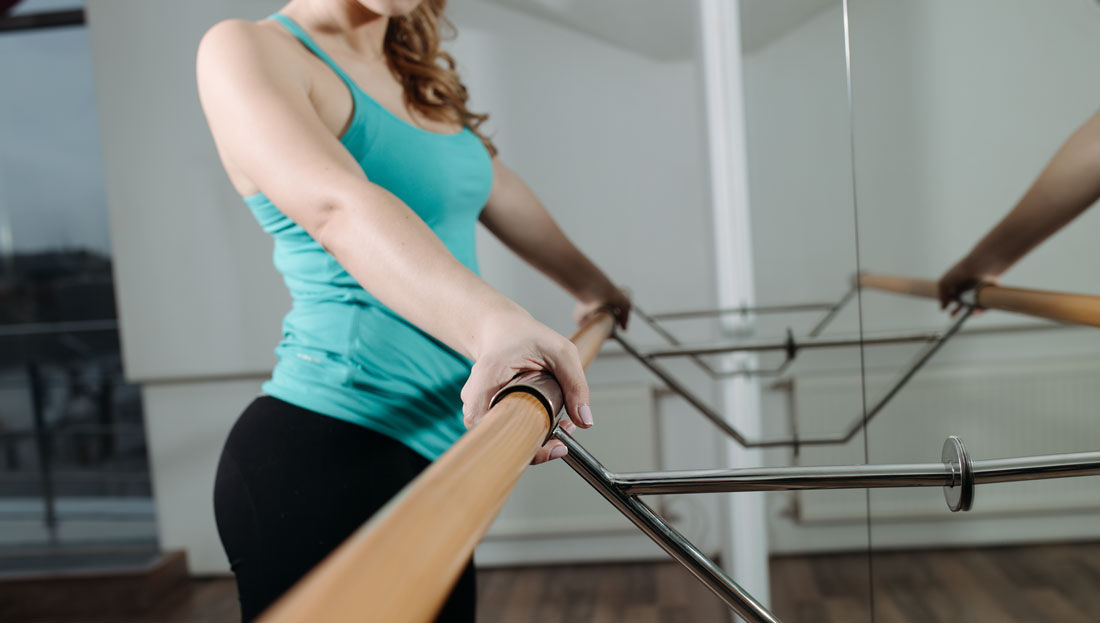
Barre-based exercise classes have become increasingly popular over the past decade, with more and more Americans turning to smaller, boutique studios to meet their specific fitness needs.
Barre classes, which go by a variety of trademarked names including Bar Method and Pure Barre, is a group fitness format that features exercises that utilize the bar commonly used in a traditional dance studio plus resistance such as light dumbbells, small inflatable balls and light resistance bands and tubing, as well as body-weight exercises. Traditional barre classes typically focus on exercises that help participants with posture, alignment and proper engagement of the core stabilizer muscles used for many positions that must be held for extended periods of time. An important feature of barre workouts is holding a position to keep the engaged muscles under isometric tension.
Rarely does the mention of barre elicit a neutral response from people who have tried it—they usually love it or hate it. This is especially true among those in the fitness industry. While some see it as a fun and effective workout, others question the functionality and usefulness of performing so many repetitions of movements requiring so little range of motion. To date, little published research has focused on the effectiveness of barre exercise, but previous research into high-volume exercise makes it possible to glean some insight into what might be happening to the muscles during a barre workout. Additionally, given the popularity of barre classes, the opportunity to teach this format has never been greater, and health and exercise professionals who are looking to expand their offerings may find barre to be a good fit. A quick note: While this article provides a few details about various barre studios, it is by no means an exhaustive list. The studios mentioned here—and the details of their training programs—are offered as examples of the types of training these programs require of their instructors. If you are interested in pursuing training from any organization, take the time to do your homework to make sure it is a good fit for your needs and requirements.
Let’s take a closer look…
A Brief History of Barre in the United States
Barre was originally created as an exercise format in the late 1950s by Lotte Berk, a London-based dancer who needed exercises to help strengthen her injured back. Lydia Bach, a student of Ms. Berk’s in London, brought barre to the United States when she opened the Lotte Berk Method fitness studio in New York City in the early 1970s. When the Lotte Berk studio announced that it was closing in 2005, one of its members, Jennifer Vaughan Maanavi, couldn’t stand the thought of being without her favorite exercise format. She persuaded one of Berk’s instructors, Tanya Becker, to open Physique 57 in Manhattan, which has been credited, among others, of sparking the boutique fitness studio trend. Today, in addition to offering classes at its physical locations in New York City, Bangkok, Beverly Hills, Dubai and the Hamptons, Physique 57 offers streaming workouts online so that anyone can experience the benefits of a barre workout at any time. Physique 57 offers instructor training to only the instructors it hires for its physical locations. Physique 57 instructors have 90 days to complete a 200-hour course before they are allowed to start teaching in the studio. Only 5% of instructors who enter their training program are hired to teach for the studio.
Becker, an ACE Certified Group Fitness Instructor, describes the Physique 57 approach to barre as “interval overload” that alternates between large, multijoint movements and isolated, single-joint position holds where participants are challenged to keep muscles under isometric tension with limited movements referred to as “pulses” for strength in addition to body-weight movements that elevate the heart rate for cardio-based intervals. “Our approach is focused on low-impact movements that take the muscles to a point of fatigue,’ explains Becker, “Our members love it because they can get both cardio and strength training in the same workout and it is completely adaptable to all skill levels.”
In 1980, Elisabeth Halfpapp, a former ballet dancer, answered an ad for an instructor at the original Lotte Berk studio in New York City, and has since been a proponent of the method for nearly four decades. Halfpapp went on to start the Exhale Spa and Studio in New York City with her husband Fred Devito, the first male barre instructor in the U.S. Halfpapp describes barre as combining exercises to improve postural alignment along with those from dance and ballet for a “total-body workout based on both strengthening and stretching the muscles.” Exhale has a number of physical locations that offer live classes in addition to on-demand workouts accessible to anyone with a device and an Internet connection.
When asked to discuss the primary benefits of barre workouts, Devito is quick to start naming them, including barre’s accessibility to all ages and its low risk of injury. “We have members in their 70s who have been working out with us for years and who now have both their children and grandchildren exercising with us,” states Devito. “Barre [also] helps reinforce proper carriage and alignment, which helps our members become strong without beating up their bodies.” Like Physique 57, Exhale Studio offers an instructor education program to help fitness instructors learn how to teach barre workouts using the same techniques originally taught by Lydia Bach, who first introduced Lotte Berk’s workouts to the U.S.
Why Have Barre Workouts Become So Popular?
Devito, who earned a degree to become a physical education teacher before his eventual career as a studio owner and barre instructor, claims that barre helps students “learn about proper alignment and positioning, which can help increase strength while also improving movement skill. [This means] that almost everyone can benefit from a barre workout while having a low risk of injury when compared to other forms of exercise.”
Becker believes that the influence of dance—specifically ballet—is at the heart of barre’s popularity. “Even as new methods of teaching barre have been introduced over the years, because it mixes principles of ballet and dance with exercise, it allows participants to reap the benefits of training like a dancer without having to spend hours rehearsing in a studio.”
Lauren George is the co-owner of the Clemson Fitness Company, a boutique studio featuring a variety of formats, including barre, in Clemson, S.C. She’s also cocreator of the Barre Above instructor education program. “Our members love the barre classes because everyone can feel successful doing the workout. Our members tell me they like barre because it helps them to both feel stronger and move better,” she says.
“I started barre in 2012 at the suggestion of a coworker who now owns her own barre studio. I tried it and like it because it’s a good way to balance out my higher-impact workouts,” says Anne Marie Power, a fitness consumer based in Alexandria, Va. “One of the things I like about it is that in addition to a good workout, I'm forced to stretch, which is something I definitely don’t do enough of on my own.”
Courtney Mitchell, a group fitness instructor living in the Boston area, has been doing barre classes since 2004 because she enjoys both the workouts and the people with whom she does them, which increases the fun factor exponentially. Plus, “I definitely feel like I’ve gotten stronger and have improved my mobility. As I learned how to become a fitness instructor myself, I’ve realized some of the repetitive movements could cause an injury if not performed correctly. But the bottom line is that I really like the workouts and feel fitter as a result.”
What the Research Says
Research on the benefits of a specific barre format have not been published in a peer-reviewed journal. Therefore, it is necessary to review the research on high-volume strength training exercise in an attempt to extrapolate specific, quantified benefits of the workout.
A muscle contracts in response to signals from the muscle motor units, which are the connections between the central nervous system and individual muscle fibers. The more a muscle is contracted during exercise, the more motor units are activated. An important factor in activating muscle motor units is time under tension (TUT)—the duration a muscle stays under tension could help initiate changes like strength gains and muscle growth. A high volume of repetitions such as those found in barre classes definitely increase the TUT of the involved muscle fibers, which can provide benefits like improving muscular endurance of type I muscle fibers. In addition, when an exercise is performed to the point of fatigue, or the inability to complete another repetition, that’s a sign that all muscle motor units potentially have been activated, so barre may be effective for stimulating the type II muscle fibers responsible for muscle growth as well (Schoenfeld, 2016).
Two conditions stimulate changes to muscle tissue: metabolic and mechanical overload. Metabolic overload is performing repetitions to the point of fatigue to deplete the available muscle glycogen. The result is that muscle cells become more efficient at storing glycogen (and water), which can help increase muscle fiber cross-width. Mechanical overload is the structural damage to muscle fibers as the result of repetitive activation. Both create the stimulus for muscle growth but because they cannot be isolated, it is not possible to identify which is the more important stimulus (Schoenfeld, 2016). The higher rep ranges for barre workouts could create the mechanisms to produce both types of overload. “Increasing the intensity of a strength exercise [usually] means adding more weight. The high-volume protocols of barre show that adding more repetitions can be another way to increase the intensity of a strength exercise,” claims Appel.
Although it is not in specific reference to barre exercise formats, evidence can be found to support the high ranges of repetitions promoted by barre formats. For example, in a 2017 study published in Sports Medicine, Figueredo and colleagues suggest that, “In resistance-training programs intended to promote muscle hypertrophy and health, both intensity and volume can be manipulated. However, in some cases, increasing the volume [of repetitions] can be better tolerated than increasing the [amount of] intensity.”
In a meta-analysis of the research literature on muscle hypertrophy, Schoenfeld and colleagues observed, “Emerging evidence indicating fiber type−specific adaptations from training with high vs. low loads suggests a potential benefit to training across a spectrum of loading zones when maximizing muscle hypertrophy is the primary goal…Our findings therefore indicate that while heavy loads are required to achieve maximal gains in isotonic strength, lighter loads promote substantial increases in this outcome as well.” (Schoenfeld et al., 2017). This suggests that when it comes to strength training exercise for the purpose of improving muscle growth, both low and high load training contribute to improved isotonic muscular strength.
An earlier meta-analysis of the research on the mechanisms of muscle hypertrophy noted that previous studies had shown that when taken to the point of concentric failure, “muscle growth is comparable regardless of the training intensity utilized.” The authors asserted that these findings were “consistent with the premise that fatigue reduces motor unit recruitment thresholds, thereby enhancing muscle recruitment. It is therefore possible that the utilization of concentric muscle failure in training may negate the impact of, or equate the effect of, different repetition durations such that muscle growth is ultimately similar between conditions” (Schoenfeld and Ogborn, 2015). Effectively, this is suggesting that repetitions to a point of fatigue could be one possible mechanism for muscle growth, which provides support for the benefits of the high volume of exercise performed in a barre workout.
Is Teaching Barre Classes a Good Option for Health and Exercise Professionals?
Beyond the benefits of barre, is this modality a good option for health and exercise professionals who want to expand into teaching another form of exercise? Well, if pain-free movement is your goal, the answer is yes, according to the instructors we consulted.
“What I like about barre is that I still feel like I work hard without physically crushing my body,” says George. “As an instructor I enjoy teaching a format where participants are training like dancers, allowing them to feel both strong and graceful, which is actually very empowering.” Halfpapp and Devito happily point out that they’ve been teaching barre nonstop for almost four decades and are still going strong as a result of their own workouts.
But what type of skills are needed? Do you need a background in dance to teach barre? As it turns out, the same knowledge and skills that make a great group fitness instructor apply to this modality as well.
For example, Appel believes that to teach barre, instructors must be effective at cueing because the workouts involve guiding participants through a series of movements while also holding specific movements under isometric tension. “One of my favorite things about teaching barre is that it is easy on my body because I demonstrate the movements and then walk around to observe my students. I start with a large movement and then transition to small movements before holding a specific position for a period of time,” she says. “Instructors learn how to design and teach a class, which includes a number of specific segments such as having participants exercise while standing and holding on to the barre or while lying down on the floor using a piece of equipment.”
“Instructors should realize that they do not need a background in dance and that less than one-third of the [Barre Above] workout uses the actual bar from a dance studio,” explains George. “Our programs train instructors to put together classes that move through all three planes of motion to create a well-balanced and effective workout. Moving through all three planes creates functional movements that enhance daily activities. Additionally, we teach specific movement sequences that utilize multiple ranges of motion to maximize efficiency and prevent injuries.”
Lori Allen, an ACE Certified Group Fitness Instructor who teaches the Barre Burn format for Equinox in the Los Angeles area and takes barre classes from other instructors, agrees. “Barre workouts allow participants to train like dancers without having to really train like dancers,” she says. “As an instructor, I have seen women feel fit and strong from taking barre while dealing with stressful life moments like grief, heartbreak or cancer. And when I was pregnant, I both taught and took barre classes.” In fact, Allen credits barre workouts with helping her to return to her normal exercise program—which includes running and lifting heavy weights—following her pregnancy.
It’s worth noting here that, like Allen, professionals who love teaching and taking barre classes typically engage in other forms of exercise as well, such as lifting heavy weights or other forms of higher-intensity activities, depending on their strength and fitness goals. Abbie Appel, for example, who teaches barre classes in Boca Raton, Fla., and leads barre instructor training workshops for SCW Fitness, acknowledges the importance of utilizing other training methods to improve strength or achieve a specific aesthetic appearance.
“Barre is a great, low-impact workout; the high repetition ranges are a completely different type of intensity that can challenge muscles to work differently,” says Appel. “That said, as much as I like barre, I also think it is important to do proper strength training to maintain, well, strength, as well as follow a specific cardio program for aerobic fitness.” In other words, says Appel, barre is a great format, but it’s just that—a group fitness format. “Being truly fit is about being strong in a number of different exercise modalities, not just one,” she says.
Bringing it All Together
Many of the exercises in a barre workout have evolved from dance, allowing participants to experience the aesthetic benefits of training like a dancer without actually having to spend countless hours in the studio learning how to dance. For years, barre workouts have been taught by instructors with strong backgrounds in dance and movement; as these instructors gained practical teaching experience, they developed the methods and principles that have made barre a popular format today.
While every mode of exercise has its rewards as well as its inherent risks if performed incorrectly, barre exercise appears to be an effective form of exercise with a relatively low risk of injury. And, given its increasing popularity, it represents a significant career opportunity for instructors looking to expand their offerings. If you are curious about integrating barre into your personal or professional exercise repertoire—take the time to try out several different classes and/or studios in your area—there can be considerable differences in music, intensity and the formatting of the classes. Once you’ve had a chance to take several classes, you will be in a better position to determine if teaching this modality is something worth pursuing.
References
Figueiredo, V., de Salles, B. and Trajano, G. (2017). Volume for muscle hypertrophy and health outcomes: The most effective variable in resistance training. Sports Medicine, 48, 3, 499−505.
Schoenfeld, B. et al. (2017). Strength and hypertrophy adaptations between low- vs. high-load resistance training: A systematic review and meta-analysis. The Journal of Strength and Conditioning Research, 31, 12, 3508−3523.
Schoenfeld, B. and Ogborn, D. (2015). Effect of repetition duration during resistance training on muscle hypertrophy: A systematic review and meta-analysis. Sport Medicine, 45, 4, 577−585.
Schoenfeld, B. (2016). Science and Development of Muscle Hypertrophy. Champaign, Ill.: Human Kinetics.





 by
by 


